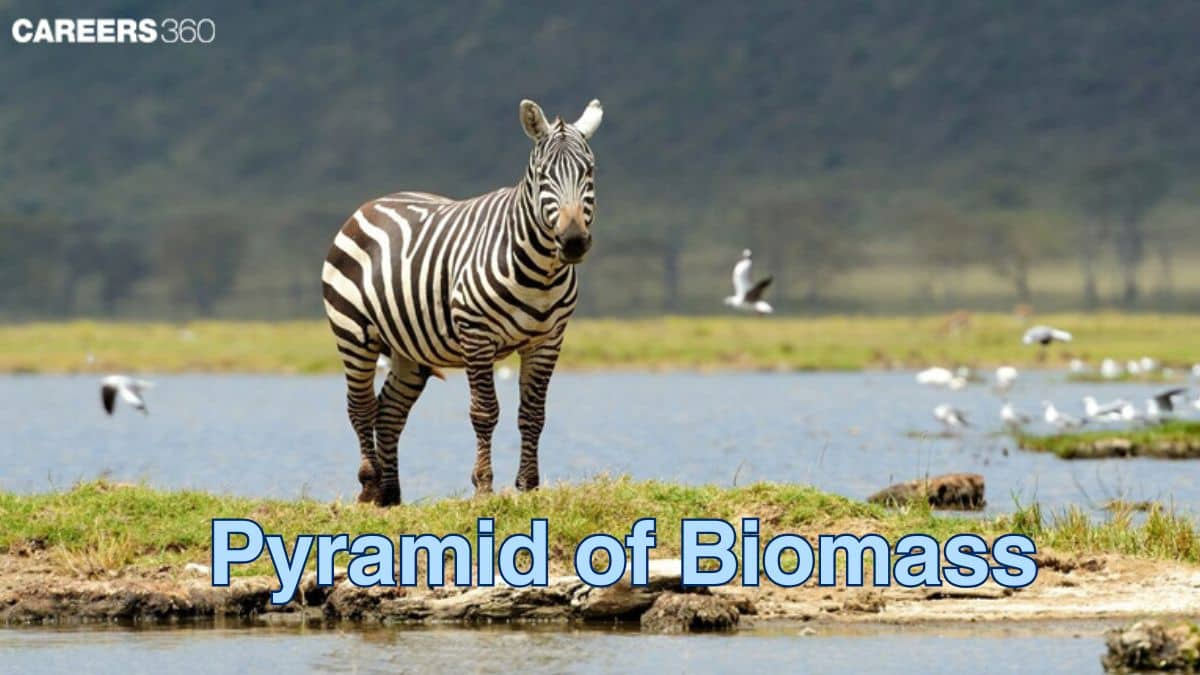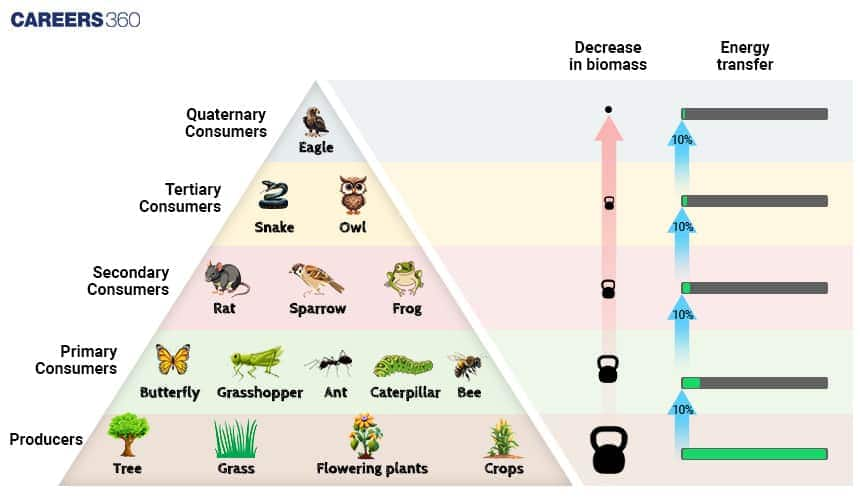Pyramid of Biomass: Definition, Examples, Examples, Function, FAQs
A Pyramid of Biomass shows the total mass of living organisms at each trophic level in an ecosystem. It reflects how energy and matter flow from producers to consumers, highlighting differences between terrestrial upright pyramids and aquatic inverted pyramids. This concept is key for NEET and Class 12 Biology.
This Story also Contains
- What is the Pyramid of Biomass?
- Components of the Biomass Pyramid
- Types of Biomass Pyramids
- Examples of Biomass Pyramids
- Factors Affecting Biomass
- Importance of the Pyramid of Biomass
- Pyramid Of Biomass NEET MCQs (With Answers & Explanations)
- Recommended Video on Pyramid of Biomass

What is the Pyramid of Biomass?
The pyramid of biomass represents the mass of living organisms at each of the trophic levels of an ecosystem. It gives a clear picture related to the distribution of biomass from producer up to the top consumer. With its help, the flow of energy and matter in ecosystems can be determined. It emphasises how efficiently energy is passed on from one trophic level to the next, and how these factors happen to affect the health of an ecosystem.
The pyramid is structured in several levels. The first level is the base containing producers such as plants and algae, these are responsible for converting solar energy into biomass via photosynthesis. The level above them consists of primary consumers, i.e., herbivores that eat producers. The ones that are next in turn are called secondary consumers. Carnivores that feed on primary consumers—the level above them is tertiary consumers. These are the apex predators that feed on the secondary consumers.

Components of the Biomass Pyramid
The components of biomass are all living biological materials, mainly plants, animals, and microorganisms, which provide different contributions to the total biomass in an ecosystem. Biomass is usually expressed in grams per square meter or kilograms per hectare. Hence, it provides a precise measure of the mass of the living organisms in a given area.
Types of Biomass Pyramids
The types of biomass pyramids depend on the ecosystem. It commonly of two types:
Upright Pyramid of Biomass
In most of the terrestrial ecosystems, the pyramid of biomass takes the shape of an upright pyramid.
This implies the relative amount of biomass of producers is significantly higher than that of herbivores consuming them. Continuing with the progression of the trophic levels, one finds a decrease in biomass.
The biomass of the herbivores is more than that of the carnivores, who are the secondary and tertiary consumers of them.
Inverted Pyramid of Biomass
Unlike the standing upright pyramid, some aquatic ecosystems often portray an inverted Pyramid of Biomass. For example, in some limnic ecosystems, there is more biomass in primary consumers like zooplankton than in the primary producers like phytoplankton.
The reason is, though highly productive and with a rapid retribution capacity, the latter is quickly being consumed by the former.
Thus, at any given time, the standing biomass of phytoplankton will always be less as compared to that of zooplankton.
Examples of Biomass Pyramids
Terrestrial biomass pyramids usually feature a high biomass at the producer level that tends to decrease progressively when climbing to the next trophic levels.
Forest Biomass Pyramid
Producers are the trees and shrubs of the forest ecosystem. This base of the pyramid is made from these plants converting solar energy into biomass by photosynthesis. Primary consumers include herbivores, such as deer, that feed on the leaves. Secondary consumers are predators, such as wolves, which depend on the herbivores as food. This arrangement lends a pyramid standing on its end, with producers holding much more biomass than herbivores and predators.
Grassland Biomass Pyramid
It is no different in the case of grasslands. Grasses are the primary producers of grasslands. Herbivores are first-order consumers. Examples include insects and grazing animals, like rabbits and antelope, which feed on the abundant grasses. Primary consumers are, in turn, eaten by birds and small mammals that feed on them as predators, the second-order consumers. The biomass will decrease from grasses to herbivores to predators again, showing an upright pyramid.
Marine Biomass Pyramid
In a marine ecosystem, primary producers are phytoplankton, small photosynthetic organisms, which become the base of the pyramid. Zooplankton, the primary consumers, feed on phytoplankton. Secondary consumers include small fish that feed on zooplankton, and tertiary consumers include larger fish and marine mammals. Productivity in the case of phytoplankton is very heavy, but the biomass of the zooplankton at any time can exceed the value of phytoplankton, giving an inverted pyramid of biomass.
Freshwater Biomass Pyramid
Algae are the primary producers in many freshwater systems, such as in lakes and rivers. In many instances, the next link in the food chain is made up of zooplankton, which feed on the algae. The zooplankton then provide food for primary consumers or insect larvae. These insect larvae are then consumed by fish, which in turn become the secondary consumer. The great turnover of algae may sometimes lead to inverted biomass pyramids, as in marine systems, and in most cases, it normally becomes upright.
Factors Affecting Biomass
The biomass in an ecosystem depends on environmental as well as anthropogenic activities.
Abiotic Factors (Light, Temperature, Water)
A variety of factors affect biomass in an ecosystem. These may be abiotic or environmental factors.
Light availability, temperature conditions, and water supply are some significant factors that determine the rate of photosynthesis in producers and consequently affect the biomass produced.
Favorable conditions enhance the potential of growth rates while the extremes can lead to reduced productivity.
Human Activities (Deforestation, Agriculture, Invasive Species)
Human activities have large effects on biomass dynamics.
Invasions of alien trees increase biomass to negative changes in the system of biomass management.
Deforestation decreases biomass through habitat destruction and reduction in photosynthetic capacity.
Agricultural land use may enhance or reduce biomass depending on the management practices applied.
Importance of the Pyramid of Biomass
The pyramid of biomass gives a clear picture of how energy moves along the trophic levels in an ecosystem. It has other importance, like:
The pyramid of biomass is utilised as a measure of energy flow and indicates the level of organisation within an ecosystem.
The pyramid of biomass gives a graphic representation of energy-performing stages. It depicts the low-level decrease of biomass at mountaintops and shows energy transfer efficiencies from the producer to the consumer.
It helps to study the balance and health of the ecosystem.
Analysis of how the biomass is spread out through the trophic levels tells us the structure and steadiness of the respective ecosystems.
It guides conservation action by determining the most critical level of trophic influence and an understanding of biomass dynamics.
Pyramid Of Biomass NEET MCQs (With Answers & Explanations)
Important topics that can be asked in NEET exam are:
Types of Biomass Pyramids (Upright and Inverted)’
Examples of Biomass Pyramids (Forest, Grassland, Marine and Freshwater)
Importance of Biomass Pyramids
Practice Questions for NEET
Q1. An inverted pyramid of biomass can be found in which the ecosystem?
Forest
Marine
Grassland
Tundra
Correct answer: 2) Marine
Explanation:
In marine ecosystems, the biomass pyramid is inverted because phytoplankton, though small, have a high turnover rate and are consumed quickly by larger organisms. Fish, which are much larger, accumulate more biomass despite consuming a lot of phytoplankton. As a result, the total biomass of fish is greater than that of the phytoplankton, creating an inverted pyramid.
Hence, the correct answer is option 2) Marine.
Q2. Which of the following statements is true about the Pyramid of Biomass?
It always shows a pyramid shape in all ecosystems.
It represents the total mass of organisms in a given area.
It is a graphical representation of the energy available at each trophic level.
It can never be inverted in an ecosystem.
Correct answer: 2) It represents the total mass of organisms in a given area.
Explanation:
A pyramid of biomass essentially quantifies the total living or organic matter present in a specific area at each trophic level within an ecological community. This includes the biomass of producers, such as plants, at the base, followed by herbivores that consume these plants, and subsequently, the carnivores that feed on the herbivores, known as first-level carnivores. The biomass is measured in units of mass per unit area.
It's crucial to note that in terrestrial ecosystems, the biomass typically decreases as we ascend the pyramid. For example, the biomass of a solitary tree is significantly greater than the collective biomass of various birds that depend on it for food. Similarly, the biomass of these birds is substantially more than their parasites. This inverse relationship between biomass and trophic levels is a common observation.
In aquatic ecosystems, particularly the sea, we often encounter an inverted pyramid of biomass. This phenomenon arises because the biomass of fishes, which occupy higher trophic levels, frequently surpasses that of phytoplankton, the lowest producer. Phytoplankton, despite their small size, are the foundation of the aquatic food chain due to their high reproduction rates and vast numbers. Consequently, the inverted pyramid in the sea is quite typical, reflecting the disproportionate biomass distribution among various trophic levels in marine environments.
The structure of these pyramids provides insights into the efficiency of energy transfer and the complex interactions that define an ecosystem's structure and function. The clarity and simplicity of the concept are essential for a comprehensive understanding of ecological dynamics.
Hence, the correct answer is option 2) It represents the total mass of organisms in a given area.
Q3. In an ecosystem, which of the following is the most common shape of the Pyramid of Biomass?
Inverted Pyramid
Diamond shape
Hourglass shape
Pyramid shape
Correct answer: 4) Pyramid shape
Explanation:
"In most ecosystems, the shape of the Pyramid of Biomass is a pyramid, where the biomass of the lower trophic levels is higher than the biomass of the higher trophic levels."
This is because, in most ecosystems, the biomass of the lower trophic levels is greater than the biomass of the higher trophic levels due to the transfer of energy between trophic levels being less than 100% efficient. This results in a decrease in biomass and energy available at each higher trophic level.
Hence, the correct answer is option 4) Pyramid shape.
Also Read:
Recommended Video on Pyramid of Biomass
Frequently Asked Questions (FAQs)
It comments on energy flow and features a trophic structure. It, therefore, helps ecologists understand issues concerned with the stability of ecosystems, biodiversity relationships, and impacts of disturbance or environmental change.
It is correct that human activities, related to deforestation and agriculture, significantly affect biomass in ecosystems. Whereas deforestation reduces biomass through the loss of habitat and reduced photosynthetic capacity, sustainability in agriculture may either increase or decrease biomass through habitat loss and pollution.
It's a graphical representation that can be used to indicate the total mass of living organisms within each trophic level in the ecosystem. In other words, it is a relationship where the mass decreases from producers up to the top consumers, hence denoting energy efficiency during transfers.
In an ecosystem, this biomass is quantified by measuring the total mass of living organisms per unit area, mostly in g/m² or kg/ha. This provides a basis for trying to assess the productivity of, and thus the health of, ecosystems.
An upright pyramid in biomass is typical in terrestrial ecosystems, where the biomass of producers outweighs that of consumers. On the contrary, an inverted pyramid occurs in some aquatic ecosystems where the species at the primary consumer level, for instance, zooplankton, outweigh the producers, phytoplankton.